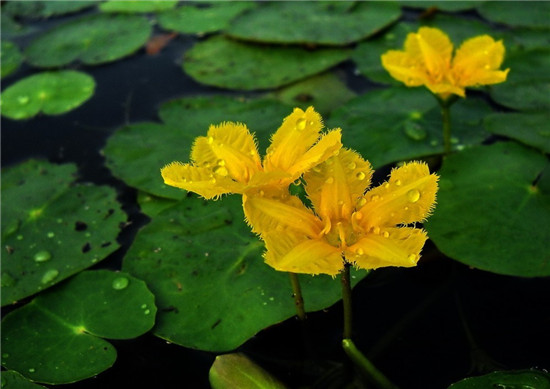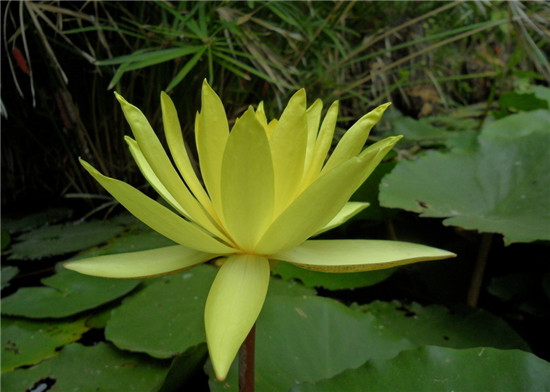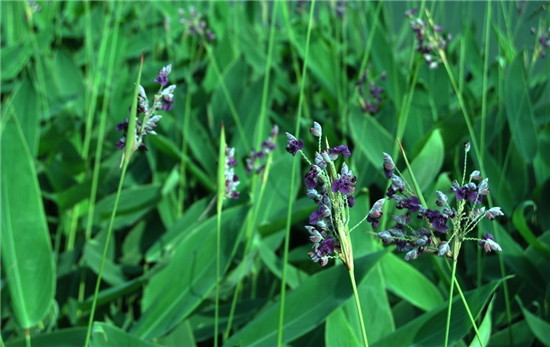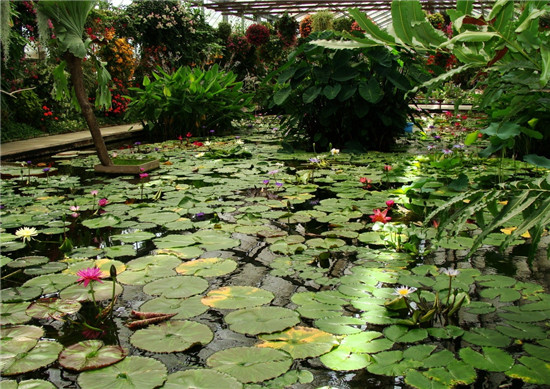Aquatic plants introduce the species of aquatic plants
Aquatic plants play a very important role in improving the indoor environment and air. Many people put some aquatic plants at home. Next, let's learn about aquatic plants and their species.

Brief introduction of Aquatic plants
Aquatic plants are those that live in water all or most of their life and can reproduce the next generation smoothly. According to the distribution in water, it can be subdivided into three types: submerged plants, floating plants and effluent plants. Such as lotus, lotus, stone sunflower, water plants and so on.
The leaves of aquatic plants are soft and transparent, and some are filamentous, which can greatly increase the contact area with water, so that the leaves can maximize the light and absorb little carbon dioxide dissolved in the water, so as to ensure the photosynthesis.
Aquatic plants have well-developed aerated tissue, and the holes are connected to each other to form a network of channels to transport gas, which can survive even if they grow in sludge without oxygen or lack of oxygen. Ventilatory tissue can also increase buoyancy and maintain body balance.

The epidermis of aquatic plants is very thin, which can absorb water and nutrients directly from water, and their roots are underdeveloped. The roots of some aquatic plants do not absorb water and nutrients, but are mainly used for fixation.
In the aquatic environment, there are many kinds of algae and all kinds of aquatic plants, which are the feed for livestock, the food for fish or the breeding place for fish.
Classification of aquatic plants
According to their lifestyle, aquatic plants are generally divided into the following categories: water-bearing plants, floating-leaf plants, submerged plants and floating plants.
Water-holding plant
The water-standing aquatic plants are tall and colorful, and most of them are divided into stems and leaves; erect and straight, the lower or base water plants sink in the water, the roots or stems grow in the mud, and the upper plants stand out of the water. There are many kinds of water-standing plants, such as lotus, calamus, spring onion, Zili flower, barracuda grass, flower Reed, cattail, alisma alisma, umbrella grass, Reed and so on.

Floating leaf plant
Floating-leaf aquatic plants have well-developed rhizomes, large flowers, colorful flowers, no obvious aboveground stems or thin stems that can not stand upright, and their leaves float on the water. Common species are king lotus, water lily, Pingpeng grass, Euryale seed, herb and so on. Floating leaf plants are: water lilies, green vegetables, water turtles, Euryale seeds and so on.
Floating plant
There are few species of floating aquatic plants, the roots of these plants do not grow in the mud, the plants float on the water surface, drifting with the current, wind and waves everywhere, most of them are mainly foliage, providing decoration and shade for the pond water. And because they can absorb minerals from the water. At the same time, it can shield the sunlight into the water, so it can also inhibit the growth of algae in the water. Floating plants grow fast and can provide cover decoration for the water surface more quickly. However, some varieties grow and multiply very rapidly and may become a pest in the water, such as water hyacinth.

Submerged plant
The rhizome of submerged aquatic plant grows in mud, and the whole plant sinks into water with well-developed aerated tissue, which is beneficial to the gas exchange of submerged plant. Most of the leaves are long and narrow or filamentous, which can absorb some nutrients in the water and can grow and develop normally under the condition of weak light under water. There are certain requirements for water quality, because the turbidity of water quality will affect its photosynthesis. The flowers are small, the florescence is short, and the leaves are mainly ornamental.
Recommendation of aquatic plants
1. The dragon blood tree of Liliaceae is an evergreen erect shrub, which is suitable for indoor hydroponics. The leaves of Fugui bamboo are green, the color is dark green, and the stems are straight and round like bamboo. Leaves ovate, apex pointed, petiole base clasping. It is a very shade-tolerant plant and can still grow well, tall and straight and strong under weak light conditions. Can be placed indoors for a long time to watch, do not need special maintenance, as long as there is enough water, can exuberant growth. In hydroponic culture, the stem of Fugui bamboo was cut into small segments of more than 20 cm as cuttings in water, and as long as the cuttings were soaked in water, they could take root and survive.
2. Amorphophallus Linnaeus in Araceae, which belongs to climbing vine and foliage flowers. Sexual preference for warm and humid environment, rattan can be up to several meters long, there are air roots at internodes, leaves will grow bigger and bigger, leaves alternate, evergreen. The stem of the radish is soft and the leaves are delicate. Water culture is very simple, make sure to change the water every 2 to 3 days, and then match it with simple nutrients. Green pineapple has a high ornamental value, the vine stem is naturally drooping, which can not only purify the air in the house, but also make full use of the space, adding lively lines and bright colors to the rigid cabinet.
3. Araliaceae, ivy, is the most ideal indoor and outdoor vertical greening varieties, evergreen vines, thin and soft branches, with aerial roots, can climb on other objects. The leaves are alternate, the leaves are triangular-ovate, and the demand for potted plants is increasing day by day. It is a typical negative plant, which can grow in full light, grow well in warm and humid climate, and is not resistant to cold. Water is easy to raise and has strong vitality.
The above is the introduction of aquatic plants and the species of aquatic plants that I have summarized for you. I hope this article can help you. Please continue to follow us.
The leaves will grow bigger and bigger, and the leaves will be alternate and evergreen. The stem of the radish is soft and the leaves are delicate. Water culture is very simple, make sure to change the water every 2 to 3 days, and then match it with simple nutrients. Green pineapple has a high ornamental value, the vine stem is naturally drooping, which can not only purify the air in the house, but also make full use of the space, adding lively lines and bright colors to the rigid cabinet.
3. Araliaceae, ivy, is the most ideal indoor and outdoor vertical greening varieties, evergreen vines, thin and soft branches, with aerial roots, can climb on other objects. The leaves are alternate, the leaves are triangular-ovate, and the demand for potted plants is increasing day by day. It is a typical negative plant, which can grow in full light, grow well in warm and humid climate, and is not resistant to cold. Water is easy to raise and has strong vitality.
The above is the introduction of aquatic plants and the species of aquatic plants that I have summarized for you. I hope this article can help you. Please continue to follow us.
Related
- Wuhan Hospital Iron Tree Blooming Result Was Instantly Frightened by the Gardener Master
- Which variety of camellia is the most fragrant and best? Which one do you like best?
- What is the small blue coat, the breeding methods and matters needing attention of the succulent plant
- Dormancy time and maintenance management of succulent plants during dormancy
- Minas succulent how to raise, Minas succulent plant pictures
- What are the varieties of winter succulent plants
- How to raise succulent plants in twelve rolls? let's take a look at some experience of breeding twelve rolls.
- Attention should be paid to water control for succulent plants during dormant period (winter and summer)
- Watering experience of twelve rolls of succulent plants
- Techniques for fertilizing succulent plants. An article will let you know how to fertilize succulent plants.



